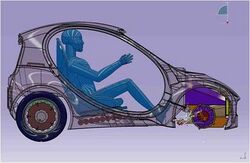Engineering:Riversimple Urban Car
The Riversimple Urban Car is a conceptual open source hydrogen fuel cell vehicle that was proposed by Hugo Spowers' company, Riversimple, in 2009. Their latest model, the Rasa, was unveiled on 17 February 2016.
A working prototype vehicle was unveiled at the Somerset House in London on 16 June 2009, and (As of 2009), with production initially planned to begin by 2013.[1] The plan has been subsequently superseded with the intention to develop a production vehicle of a similar format but with a new design in 2018–19.
Design
The Riversimple Urban Car was designed and developed in the United Kingdom by teams at Cranfield and Oxford Universities. It was backed by Sebastian Piech, the great-grandson of Ferdinand Porsche.[2]
The Urban Car is a two-passenger vehicle about the size of a Smart. It weighs 772 pounds (350 kg), and the prototype was constructed of a Carbon fiber composite material body.[3] The car can reach speeds of 50 mph (80 km/h) and travel for 240 miles (390 km) on 2.2 pounds (1.00 kg) of hydrogen before refueling.[4] 2010 calculations showed it could achieve the equivalent of up to 300 mpg in hydrogen,[2] and a life cycle assessment carbon emissions of less than 30g CO2/km.[5][needs update]
Operation
The Urban Car is powered by a fuel cell from Horizon Fuel Cell Technologies[6] that converts hydrogen into electricity. This power supply functions like a battery, uses no moving parts, and emits only pure water. There are two novel principles involved with this project: decoupling of acceleration from cruising, and mass decompounding.
Decoupling acceleration and cruise means that the fuel cell will only need to be large enough to supply the power needed for maintaining a constant speed, which is about 20% of the power needed for acceleration. Most of the car's braking is done by electric motors on each wheel. These motors capture the energy of the car in motion, and store it as electricity in a bank of electric double-layer capacitors (ultra-capacitors). This electricity is used to provide 75% of the power used in acceleration. Because of this, the Urban Car can be powered by a 6 kW fuel cell, which is significantly smaller than the Honda FCX Clarity's 100 kW fuel cell. This requires less hydrogen to be stored on board, and results in an overall lighter vehicle.[5]
Mass decompounding involves designing the car as a complete system, as opposed to redesigning a car originally conceived as being powered by an internal combustion engine into a fuel cell vehicle. The combination of a small fuel cell, along with elimination of the unnecessary gearbox, drive shafts, power-assist systems, and associated components, results in a very lightweight vehicle.[5]
Retail and licensing
(As of February 2010), Riversimple planned to lease the cars over 15 years instead of selling them, with fueling included in the leasing cost. This was intended to increase the life of the vehicles, and reduce materials usage.[3] The cost of the lease was expected to be about £200 (US$330) per month.[4]
(As of 2010), the open source design for the Riversimple Urban Car was planned to be stored on the 40 Fires wiki site online. The wiki project is called The Hyrban.[5] At that time, Riversimple planned to lease the design to any small manufacturer for free, modify it as desired, and build their own version of the vehicle.[7]
The CAD models for the Riversimple Hyrban technology demonstrator have been released[when?] under a Creative Commons license, attribution 3.0. [8][9]
See also
- Hydrogen economy
- Morgan LIFEcar
- List of fuel cell vehicles
References
- ↑ Dugdale, Addy (2009-06-17). "dvice.com". dvice.com. http://dvice.com/archives/2009/06/riversimple-urb.php. Retrieved 2010-02-08.
- ↑ 2.0 2.1 "Autocar article". Autocar article. 2009-06-09. http://www.autocar.co.uk/News/NewsArticle/AllCars/240683/. Retrieved 2010-02-08.
- ↑ 3.0 3.1 "Riversimple website". Riversimple.com. Archived from the original on 17 March 2011. https://web.archive.org/web/20110317105213/http://www.riversimple.com/Content.aspx?type=7&mode=menu&key=136c7243-2378-407e-96cf-750d15de37a8. Retrieved 2010-02-08.
- ↑ 4.0 4.1 "engadget.com". Engadget. https://www.engadget.com/2009/06/16/hydrogen-powered-riversimple-urban-car-unveiled-makes-your-hybr/. Retrieved 2010-02-08.
- ↑ 5.0 5.1 5.2 5.3 "Hyrban project". 40fires.org. http://www.40fires.org/Wiki.jsp?page=The%20Hyrban. Retrieved 2010-02-08.
- ↑ "AUTOPAK Automotive fuel cell System". http://www.horizonfuelcell.com/#!autopak-/cpor. Retrieved 21 July 2013.
- ↑ "An open-source hydrogen car with a Porsche pedigree". Scientific American. 2009-06-12. http://www.scientificamerican.com/blog/60-second-science/post.cfm?id=an-open-source-hydrogen-car-with-a-2009-06-12&sc=DD_20090612. Retrieved 2010-02-08.
- ↑ "Why are you making your designs available under an Open Source license?"
- ↑ "The 40 Fires Foundation takes an open source approach to developing energy-efficient technology"
External links
 |


